Child Handling Simulation on Outdoor Equipment
The simulation of child handling in outdoor equipment is a critical aspect of toy and ride-on toy testing. This section focuses specifically on the methodologies, apparatus, and criteria involved in simulating how children interact with such equipment to ensure their safety and compliance with relevant standards.
Outdoor equipment designed for children often includes playground structures, climbing frames, slides, and other interactive play installations. The simulation of child handling involves replicating real-world scenarios where a child might engage with these pieces of equipment in various ways. This process ensures that the design and construction are robust enough to withstand typical usage patterns.
The testing typically starts with an initial inspection where engineers assess the structural integrity, material quality, and overall build of the outdoor equipment. Following this, they proceed to simulate a child's interaction with the structure by applying forces and movements akin to those seen in actual play scenarios.
For instance, when simulating a child climbing up a slide or using a ladder, engineers apply loads that mimic a child's weight and movement. This helps identify any potential issues such as structural weaknesses, loose parts, or inadequate safety features. The apparatus used for this simulation includes sophisticated load cells, motion sensors, and other specialized tools that can accurately measure the forces involved.
The acceptance criteria for these simulations are derived from international standards like ISO 8124-6:2019, which specify the requirements for toys and riding-toy equipment. Compliance with these standards ensures that the outdoor equipment meets safety regulations and is suitable for children of various ages.
Engineers also consider ergonomic factors during the simulation process to ensure that the equipment is not only safe but also accessible and user-friendly for children. This includes evaluating the reachability of different parts, the ease of climbing or descending, and the overall design that promotes play and exploration without causing harm.
The results of these simulations are detailed in comprehensive reports that document all aspects of the testing process, including any deviations from standard criteria. These reports serve as a critical resource for quality managers, compliance officers, R&D engineers, and procurement teams to understand the equipment's performance and make informed decisions regarding future product improvements or regulatory compliance.
Benefits
The benefits of simulating child handling on outdoor equipment extend beyond mere compliance with safety standards. By incorporating this simulation into their testing protocols, manufacturers can significantly enhance the overall quality and reliability of their products. Here are some key advantages:
- Enhanced Safety: Simulations ensure that all potential hazards are identified and addressed early in the development process.
- Informed Design Decisions: Engineers gain valuable insights into how children actually use the equipment, allowing for more intuitive and safer designs.
- Compliance Assurance: By adhering to international standards such as ISO 8124-6:2019, manufacturers demonstrate their commitment to regulatory compliance.
- Improved Reputation: Demonstrating a proactive approach to safety can enhance the brand's reputation and customer trust.
- Economic Benefits: Early identification of issues reduces the likelihood of costly recalls or product liability lawsuits.
- Customer Satisfaction: Safer, more reliable products lead to higher customer satisfaction and increased market share.
In summary, child handling simulation is a vital component of ensuring that outdoor equipment for children meets the highest standards of safety and quality. By integrating this process into their development cycle, manufacturers can create products that not only comply with regulations but also meet the diverse needs and expectations of today's families.
Industry Applications
| Application | Description |
|---|---|
| Playground Structures | Involves simulating various climbing and sliding actions to ensure structural integrity. |
| Climbing Frames | Evaluates the stability and ease of use for children, ensuring they can climb safely without risk. |
| Slides and Ladders | Tests the durability under repeated load cycles that mimic real-world usage patterns. |
| Sandboxes and Play Areas | Ensures that these areas are free from any tripping hazards or sharp edges. |
| Tethered Toys | Verifies the safety of tethered toys when they come into contact with outdoor equipment during play. |
| Parking Structures for Ride-On Equipment | Simulates the load and movement characteristics that a child might apply while using ride-on toys in these structures. |
| Safety Features | Evaluates the effectiveness of various safety features such as handrails, guard rails, and emergency exits. |
The use of child handling simulation is not limited to a single application but spans across multiple sectors within the toy industry. This table provides a comprehensive overview of how this service can be applied to different types of outdoor equipment, ensuring that all aspects are thoroughly tested and meet safety standards.
Quality and Reliability Assurance
The process of simulating child handling on outdoor equipment is integral to the overall quality assurance framework. It involves several key steps that ensure high reliability and consistency in product performance:
Initial Inspection: This step includes a thorough examination of the structural components, materials used, and overall design of the outdoor equipment. Engineers look for any visible defects or potential points of failure.
Simulation Setup: Once the initial inspection is complete, engineers set up the simulation apparatus to replicate real-world child handling scenarios. This setup includes precise measurement tools to record forces and movements accurately.
Data Collection: During the simulation, data is collected from various sensors and instruments. This data provides a detailed picture of how the equipment performs under different conditions, highlighting any areas that need improvement.
Analysis and Reporting: After collecting all necessary data, engineers analyze it to determine compliance with relevant standards. They then prepare a comprehensive report detailing the findings and recommendations for any necessary modifications or enhancements.
The quality assurance process is iterative, meaning that each round of testing provides valuable insights into potential improvements. This continuous cycle ensures that manufacturers can consistently produce high-quality products that meet both safety and performance expectations.





